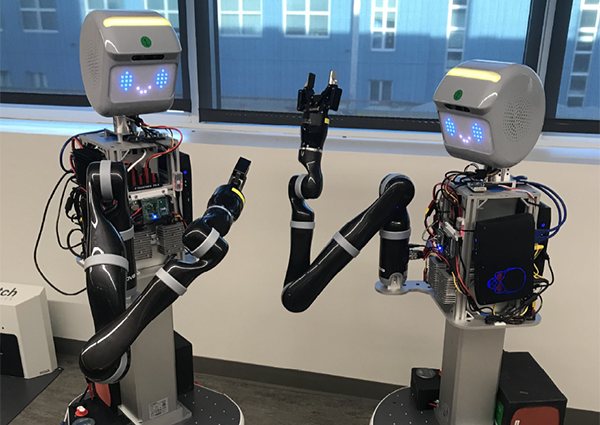Can “imperfect” human teachers help robots to become better learners?

As the fields of robotics and human-robot interaction advance, offering new ways to improve our lives, two faculty members in the School of Engineering’s Department of Computer Science—Clare Boothe Luce Assistant Professor Elaine Short and James Schmolze Assistant Professor Jivko Sinapov—are building common ground between robots and the people who use them.
Short and Sinapov recently received a gift of $150,000 from Amazon Robotics for an ambitious project called “PAInTR: Personalized AR for Intuitive Teaching of Robots” that aims “to enable flexible, natural tasking (and re-tasking) of mobile manipulation robots by non-expert users with minimal specific training.” To describe that in real-world terms, Sinapov and Short offered the following scenario:
Several robots move around the room, checking inventory and picking up and putting down objects. A user enters the room and, using a tablet or smartphone, can see status information on all the robots overlaid onto the device’s camera feed. One robot rolls up and positions itself by some objects on a table and the user helps the robot put a few of the objects into a box; the robot then picks up another few objects while the user gives feedback on the tablet and the other robots carry out small variations on the behavior and observe the results. Once user and robot are satisfied with the robot’s understanding of the task, the user hits a second button, and the entire group of robots starts packing boxes.
At the heart of the PAInTR project, says Sinapov, are two questions: “How can robots learn to do new things with only the help of non-expert users, and how can robots effectively communicate their internal states to non-expert users to facilitate effective collaboration and problem solving?” The answers depend, in part, on recognizing differences between human and robot learning.
“A lot of robotics research treats humans and human behavior as just annoying noise,” Short explains. “Here we're exploring the ways that imperfections and variations in human teaching can actually help you do better.” By creating new augmented reality (AR) interfaces that draw on the “imperfections” of human teachers, Short and Sinapov hope to make robot learning more robust. Many robotics researchers “develop their algorithms using a pre trained model,” says Short, “which is what I would call a ‘perfect teacher.’ By perfect, I don't necessarily mean that it never makes a mistake, but the feedback it gives will always be perfectly aligned with how the robot models the world.”
People, by contrast, can devise many solutions to one problem, which may make them better instructors. As Short puts it, “imperfect teachers tend to send you out to explore more.”
Short and Sinapov bring complementary expertise to the research. Sinapov’s primary interests are in artificial intelligence, robotics, and robot learning, while Short’s focus is on interactive reinforcement learning and the ways that people teach robots. Sinapov adds that Short’s work in human-robot interaction (HRI) “totally aligns with my interests in enabling robots to operate autonomously for long periods of time in the real world.” What they share, says Short, is “a foundation of algorithmic thinking and a computer science perspective.”
An abundance of robotics expertise at Tufts makes the University a beneficial collaborator to companies like Amazon. “One of the cool things about Tufts is that we have a lot of robotic strength across the School [of Engineering], including within the computer science department,” says Short. Because the field of HRI is small and concentrated in academia, partnerships like this one are a chance for mutually beneficial cross-pollination of ideas.
The PAInTR project stems in part from the work of Andre Cleaver, a doctoral student in Sinapov’s lab—a good example, he says, of the ways that graduate and undergraduate students are driving forces in Tufts’ robotics research. As interest in robotics among Tufts students continues to grow, collaborators like Amazon Robotics are creating new opportunities for hands-on learning and engagement, while helping to move robotics forward with ground-breaking research.
Department:
Computer Science